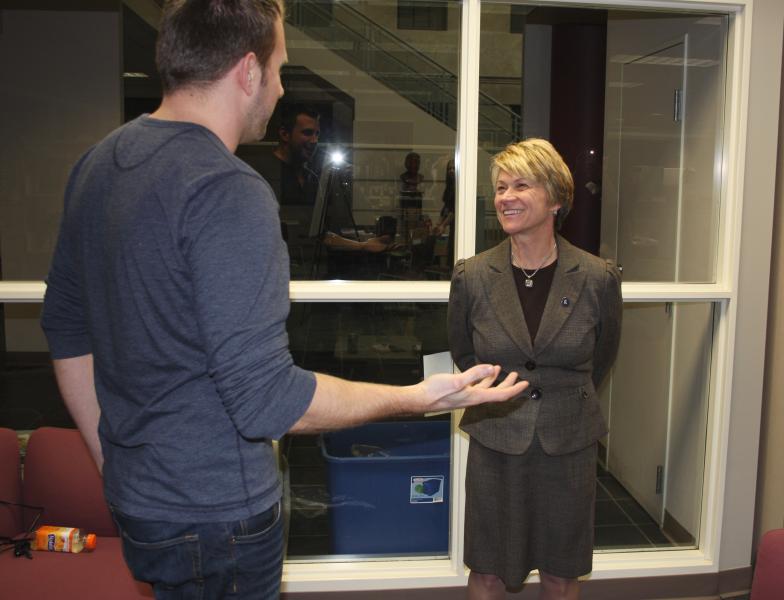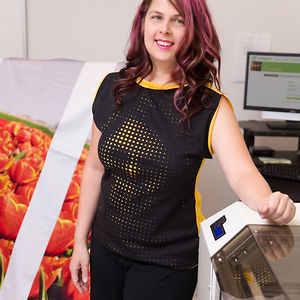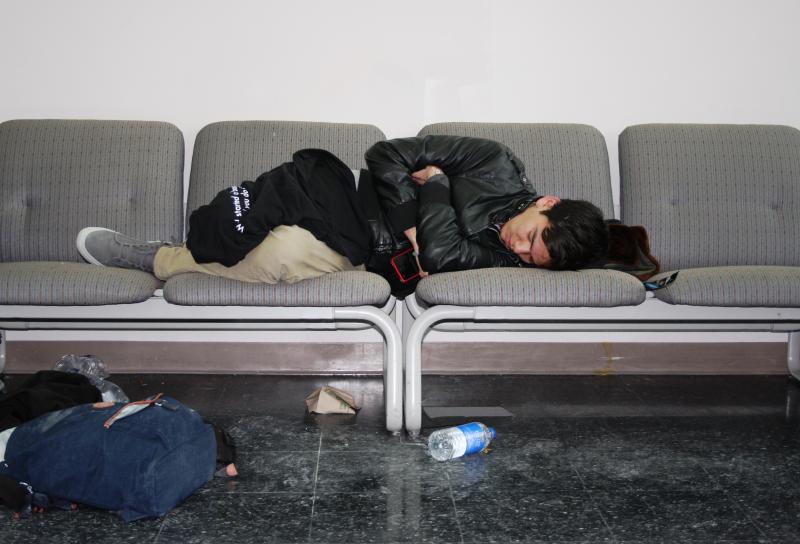Cross pollination across disciplines
Kevin Wolfgang, manager of Kent State University’s TechStyle lab, introduces the two dozen competitors to an array of raw materials.
He holds up sample of rip stop nylon, sportswear fabric, palms of gloves, rubber, "so if you want to use that, have at it…”
 There’s also a pile of circuit boards, LED lights, and computer modules. It’s a fashion / technology ‘hackathon’ sponsored by the student hacking club Hacksu, the KSU fashion school, and Blackstone LaunchPad, a private, on-campus business development franchise. There’s also a pile of circuit boards, LED lights, and computer modules. It’s a fashion / technology ‘hackathon’ sponsored by the student hacking club Hacksu, the KSU fashion school, and Blackstone LaunchPad, a private, on-campus business development franchise.
Wolfgang says computer engineers, software designers, fashion students, and marketing majors gather in a, "meeting of the minds to see what we can create.”
Wolfgang says the idea behind the competition is to spur cross pollination across disciplines.
Students from Kent State, Bowling Green, Case Western, Ohio State and beyond form teams and brainstorm overnight. The challenge is to invent a new wearable tech product and an accompanying business plan. The top prize is $2,000 in cash.
The cleavage cam, Glow shirt, and Miracle Sole
Marketing major Christopher Jones and his team are already crafting a concept.
Jones describes a product that imbeds a camera into a bra. He says the idea is to track people’s eye movements, "and when somebody glances down at a woman’s cleavage it will instantaneously take a picture and then post it to an Instagram page. The software will assemble a a reel of awkward photos, "of people caught red-handed staring at their cleavage.”
Meanwhile, Lindsay Pizzurro and her team are sketching out a safer biking shirt that people might actually want to wear.
She says for night-time biking, instead of wearing an orange reflective vest, their product is more stylish. Pizzuro describes, "a form-fitting Under Armor-looking long-sleeve shirt with flashing lights so cars will see you.”
Working alone is Kent State physics major Mitchell Gillespie. He says he’s never even sewn before.
Gillespie is putting sensors into the sole of a running shoe to help runners identify possible problems with their form. He says pressure sensors detect where a runner’s foot hits the ground.
Gillespie, himself a runner, says hitting the ground with your heel first is not really good running form, "because it sends a lot of pressure and shock to your knee." But his device can detect when you land flat footed, which he says is, "good running form.”
He had to invent the sensors from scratch from available materials.
He’s also got a name for it - The Miracle Sole.
Fashion, technology, and wearable hardware
Charles Stack is co-founder of Flashstarts, a Cleveland based business accelerator. He’s at the hackathon for a different reason, he's looking for talent.
 Stack says it’s only natural that we would want to bring computing power closer to the skin by integrating technology with fashion. Stack says it’s only natural that we would want to bring computing power closer to the skin by integrating technology with fashion.
He says as the computer has migrated from the desktop to the home to the pocket to the wrist to the eyeglasses,"that’s an increasing trend that you’re going to see.”
It’s a trend that Kent State fashion technology professor Margarita Benitez sees throughout history.
She says fashion has always been at the forefront of technology, "so it’s natural to try and find new ways of creating and new ways of expressing itself as well.”
The final judging
It’s the next day and after a sleepless night, the cleavage cam team’s Christopher Jones shares the frustrations of generations of entrepreneurs.
 He says the last 24 hours have been rough, and that despite high hopes and dreams for the product, "we’ve hit so many roadblocks.” He says the last 24 hours have been rough, and that despite high hopes and dreams for the product, "we’ve hit so many roadblocks.”
They call their product Brava.
Now, after five minute presentations from each of the 15 teams, it’s time for the judges’ decision.
An air-cooled, vented jacket takes third. The Glow team and its light-up biking shirt takes second, and fashion school director J.R. Campbell names the top design, Mitchell Gillespie’s Miracle Sole.
The judges liked his knowledge of the market and of his potential customers, along with his his functional prototype.
But when I ask Gillespie whether he’s going to take his design to the next level, he’s more ambivalent. The business can wait, for now he's planning to spend his winnings on travel.
Either way, one of the judges, NorTech's Rebecca Bagley thinks the winning concept is really the hackathon itself, bringing engineers and software designers together with the fashion school to create a spark of innovation in wearable tech. |